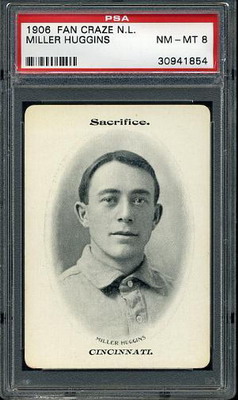

1906 WG2 Fan Craze Miller Huggins
Miller James Huggins
Born: March 27, 1879, Cincinnati, OH
Died: September 25, 1929, New York, NY Managed: St. Louis Cardinals (1913-1917), New York Yankees (1918-1929)
Elected to Hall of Fame by Veterans Committee: 1964
The smart, scrawny 5'6" Huggins was a first-rate second baseman before he became famous for managing the Yankees to their first six pennants and three World Championships. He was fast and sure-handed afield; his record is dotted with games in which he handled 15 chances, or figured in three double plays. He led the league in putouts, assists, double plays, and fielding once each, and twice in errors. The Mighty Mite was the ideal leadoff man, a switch-hitter who coaxed 1,002 career walks (four times leading the league) and stole some 50 bases a season (though stolen bases were not tabulated during his six early years with Cincinnati). Not a long-ball hitter, he did have three triples in a game in 1904.
The Cardinals acquired Huggins in 1910. By 1913 he was player-manager, and by 1917 had retired to the bench. He prodded two third-place finishes out of his nondescript team, and guided a green and awkward Rogers Hornsby through his first ML seasons. Holder of a law degree (though he never practiced) and a shrewd investor in the stock market, Huggins was businessman enough to think he could buy the St. Louis club. His bid rebuffed, he resigned. Ban Johnson, the opportunistic president of the American League, promptly urged Jacob Ruppert, the Yankees' principal owner, to grab Huggins. The manager's record was not distinguished, but he was a sound baseball man, and Johnson was happy to help steal him from the NL.
Together with imperious Ed Barrow, the GM, Huggins developed the slugging Yankee teams that ended the dead-ball era forever. A mediocre lot when he arrived, they were among the all-time greats at his death. They were a bunch of carousers and bad actors until an appalling slump in 1925 and the $5,000 fine and nine-day suspension of Babe Ruth. With Ruppert's backing, Huggins brought his unruly crew to heel, and established himself as boss, beginning the club's tradition of Yankee pride. Though history recalls the pillage of Harry Frazee's Red Sox as the making of the Yankees, Gehrig, Earle Combs, and Tony Lazzeri were discovered elsewhere, and others (Bob Meusel and Herb Pennock, for example) blossomed under Huggins's encouragement and handling. When he died of erysipelas in 1929, at age 50, judgment was nearly universal that Huggins was in a managerial class by himself. A plaque in his honor was placed in Yankee Stadium's centerfield in 1932.
Born: March 27, 1879, Cincinnati, OH
Died: September 25, 1929, New York, NY Managed: St. Louis Cardinals (1913-1917), New York Yankees (1918-1929)
Elected to Hall of Fame by Veterans Committee: 1964
The smart, scrawny 5'6" Huggins was a first-rate second baseman before he became famous for managing the Yankees to their first six pennants and three World Championships. He was fast and sure-handed afield; his record is dotted with games in which he handled 15 chances, or figured in three double plays. He led the league in putouts, assists, double plays, and fielding once each, and twice in errors. The Mighty Mite was the ideal leadoff man, a switch-hitter who coaxed 1,002 career walks (four times leading the league) and stole some 50 bases a season (though stolen bases were not tabulated during his six early years with Cincinnati). Not a long-ball hitter, he did have three triples in a game in 1904.
The Cardinals acquired Huggins in 1910. By 1913 he was player-manager, and by 1917 had retired to the bench. He prodded two third-place finishes out of his nondescript team, and guided a green and awkward Rogers Hornsby through his first ML seasons. Holder of a law degree (though he never practiced) and a shrewd investor in the stock market, Huggins was businessman enough to think he could buy the St. Louis club. His bid rebuffed, he resigned. Ban Johnson, the opportunistic president of the American League, promptly urged Jacob Ruppert, the Yankees' principal owner, to grab Huggins. The manager's record was not distinguished, but he was a sound baseball man, and Johnson was happy to help steal him from the NL.
Together with imperious Ed Barrow, the GM, Huggins developed the slugging Yankee teams that ended the dead-ball era forever. A mediocre lot when he arrived, they were among the all-time greats at his death. They were a bunch of carousers and bad actors until an appalling slump in 1925 and the $5,000 fine and nine-day suspension of Babe Ruth. With Ruppert's backing, Huggins brought his unruly crew to heel, and established himself as boss, beginning the club's tradition of Yankee pride. Though history recalls the pillage of Harry Frazee's Red Sox as the making of the Yankees, Gehrig, Earle Combs, and Tony Lazzeri were discovered elsewhere, and others (Bob Meusel and Herb Pennock, for example) blossomed under Huggins's encouragement and handling. When he died of erysipelas in 1929, at age 50, judgment was nearly universal that Huggins was in a managerial class by himself. A plaque in his honor was placed in Yankee Stadium's centerfield in 1932.